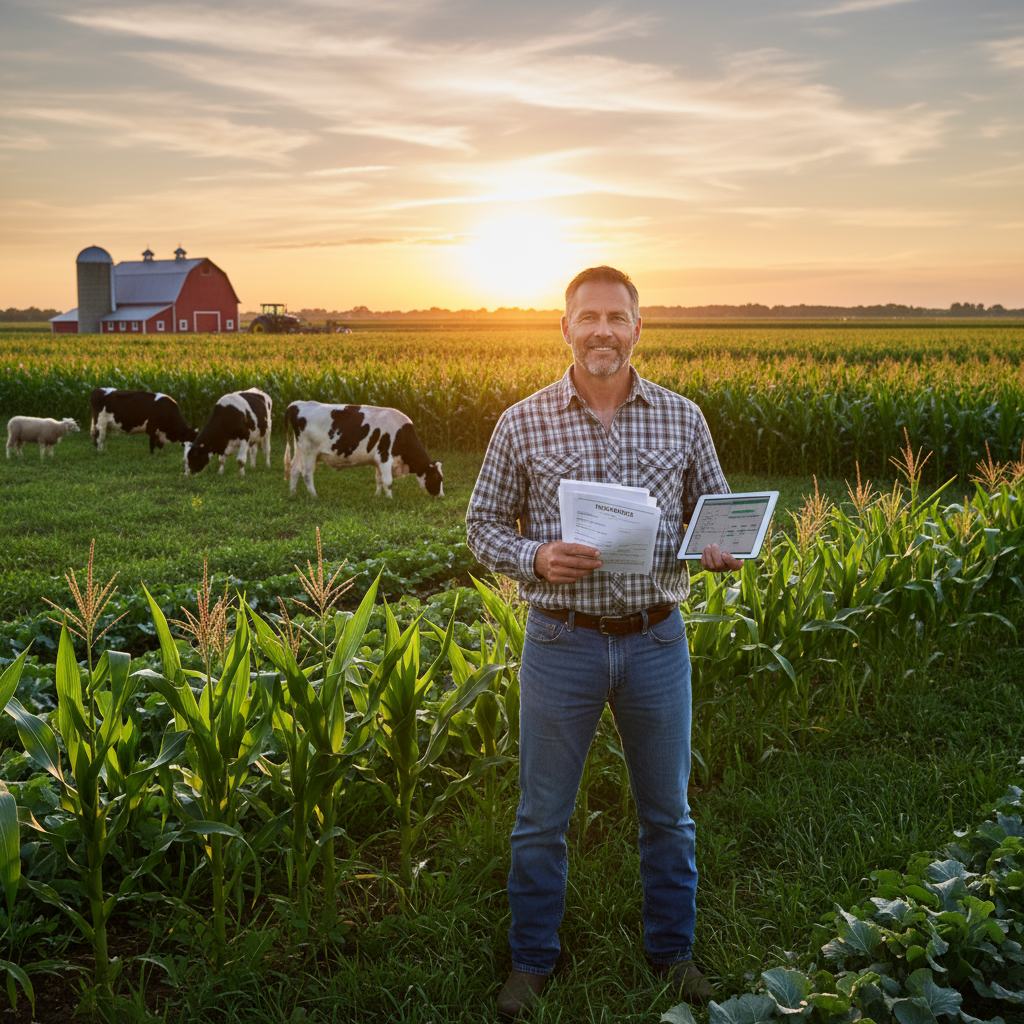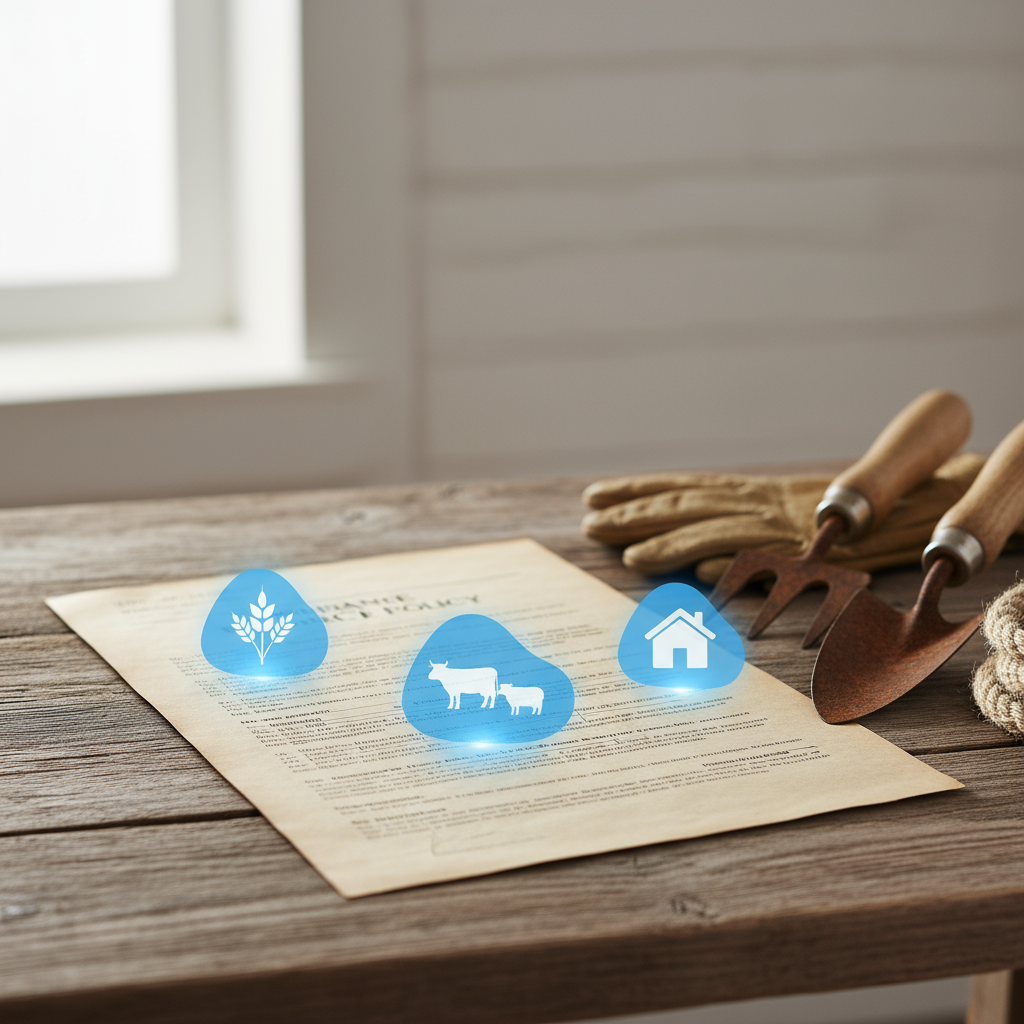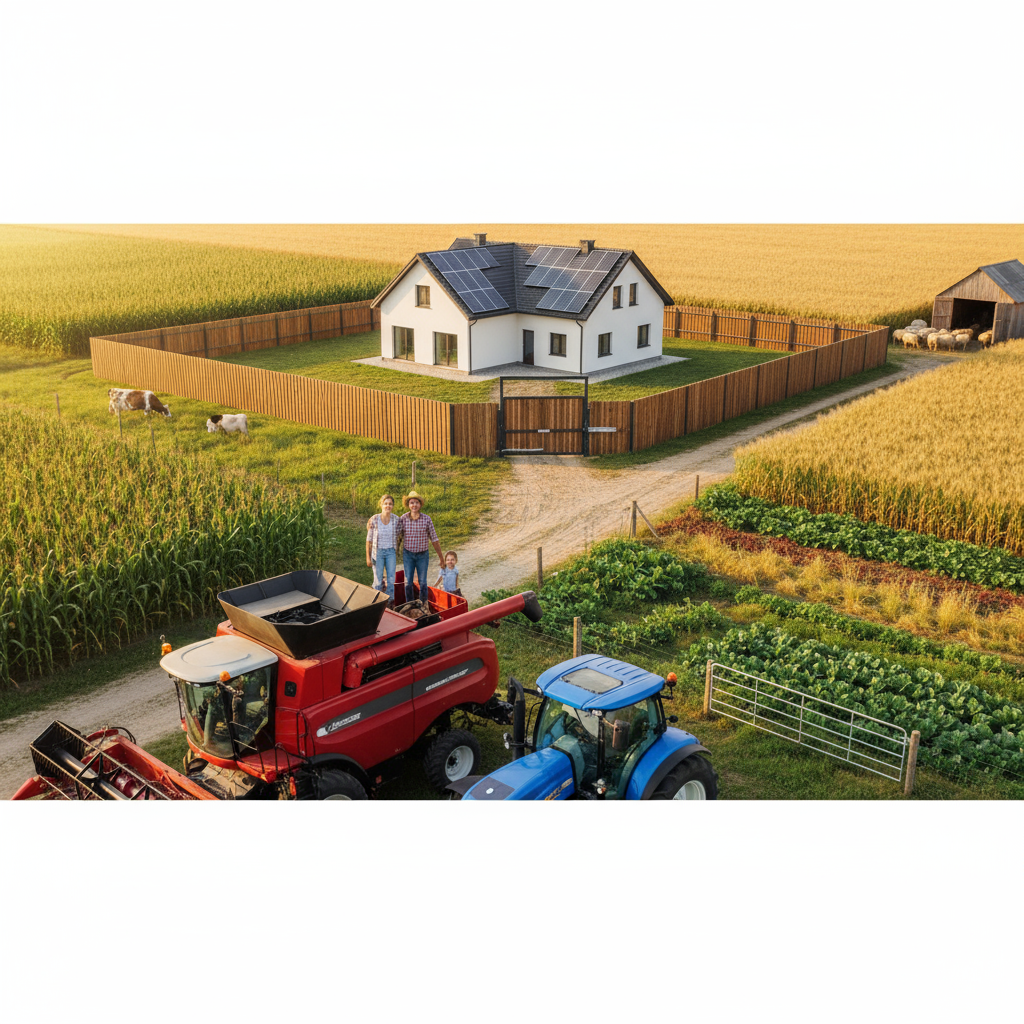
Table of Contents
Introduction
Farming feeds the world—that’s no small responsibility. But here’s what keeps many farmers up at night: the unpredictable nature of agriculture itself. One day you’re looking at a perfect crop, and the next? A hailstorm wipes out months of hard work. Equipment breaks down at the worst possible moment. Livestock gets sick. Market prices swing wildly. Sound familiar?
You’re not powerless against these challenges. Smart farmers protect themselves with insurance designed specifically for agriculture—and honestly, it’s not just smart, it’s essential. Think about it: you wouldn’t drive without car insurance, so why farm without proper coverage? The risks in farming are real and costly. Floods, droughts, storms, equipment failures, liability issues—any one of these could seriously damage your operation. That’s where understanding insurance basics becomes your friend. Once you grasp the fundamentals, you can make confident decisions about protecting your farm. And trust me, there are plenty of insurance options out there—from crop and livestock coverage to equipment and liability protection. The trick is knowing which ones matter for your specific operation.
But here’s the thing about farm insurance—it’s not just about money. Yes, it protects your financial investment. But it also gives you something invaluable: peace of mind. When you know you’re covered, you can focus on what you do best—farming. You won’t spend sleepless nights worrying about what might happen. Plus, proper insurance helps with regulatory compliance, which is becoming increasingly important. Getting familiar with the insurance underwriting process takes some of the mystery out of applications. And when you understand how to choose the right coverage, you can balance protection with costs effectively.
Let’s be honest—farming has always been unpredictable. Weather, markets, diseases, accidents—they’re part of the territory. But that doesn’t mean you have to face them defenseless. Insurance acts as your safety net, letting you take calculated risks while protecting what you’ve built. The principles extend beyond just farm coverage too. Understanding concepts like insurance and employee benefits can add extra layers of protection to your operation. It all works together to create a shield around your farming business.
What You’ll Learn in This Guide
We’re going to walk through everything you need to know about farm insurance—from the basics to the nitty-gritty details that actually matter when you’re filing a claim.
- Types of Farmer Insurance: We’ll break down the different coverage options available to farmers—crop insurance, livestock protection, property coverage, and more. You’ll learn exactly what each type covers and when you need it.
- Benefits of Insurance: Beyond just financial protection, discover how the right insurance gives you stability, peace of mind, and helps you stay compliant with regulations. We’ll show you why it’s an investment, not an expense.
- Choosing the Right Plan: Get practical advice on evaluating your farm’s specific risks, comparing insurance providers, and finding coverage that fits both your needs and your budget.
- Handling Claims: Learn what to do when disaster strikes. We’ll cover common farm insurance claims, the filing process, and how to get the best outcome when you need your coverage most.
We’ll start with the types of insurance available to farmers—because you can’t protect what you don’t understand. Then we’ll dig into the real benefits that make insurance worthwhile for your operation. After that, we’ll help you figure out which coverage makes sense for your specific situation and budget. Finally, we’ll tackle the claims process so you’ll know exactly what to do if something goes wrong.
You’ll find real-world examples throughout this guide—no insurance jargon that makes your head spin. We want you to feel confident making these decisions. We’ll also touch on related topics that round out your understanding of farm risk management. For instance, knowing about how insurance claims actually work could save you time and frustration if you ever need to file one.
By the time we’re done, you’ll have a clear picture of how to protect your farm with the right insurance coverage. Whether you’re just starting out or you’ve been farming for decades, this guide will help you make smarter decisions about protecting your livelihood. Ready to secure your farm’s future? Let’s get started.

Let’s be honest—farming insurance can feel like navigating a maze blindfolded. But here’s the thing: as a farmer, you’re already dealing with enough unpredictability. Weather that changes on a dime. Equipment that breaks at the worst possible moment. Market prices that seem to have a mind of their own. The last thing you need is to worry about whether you’re protected when things go sideways. That’s where the right insurance coverage comes in—not just as a safety net, but as your peace of mind so you can focus on what you do best: farming. So let’s break down the insurance options available to you and figure out how to choose the right protection for your specific operation.
Types of Insurance Available for Farmers: Protecting Crops, Livestock, and Property
Think of farm insurance like a three-legged stool. You need all the pieces working together to keep things stable. Farmers have access to specialized insurance products designed specifically for the unique challenges you face every day. We’re talking crop insurance, livestock insurance, and farm property insurance—each one tackles different risks that could otherwise wipe out years of hard work. Before we dive into the farm-specific stuff, it’s worth understanding the broader different types of insurance landscape and how these products fit into the bigger picture.
Crop insurance? It’s probably your most critical lifeline. When drought hits your corn or hail destroys your wheat, this coverage steps in to help you recover from losses caused by natural disasters, pest infestations, and even those frustrating market swings that can tank your crop values overnight. Livestock insurance works the same way for your animals—protecting your investment when disease outbreaks, accidents, or theft threaten your herd or flock.
Then there’s farm property insurance, which covers all the physical stuff that keeps your operation running. Your barns, fences, tractors, combines—basically everything that would cost a fortune to replace if fire, storms, or thieves decided to pay you a visit. (And trust me, you don’t want to learn the hard way how expensive it is to rebuild from scratch.) Understanding how insurance deductibles work can help you balance your premiums with your out-of-pocket costs, so you’re not overpaying for coverage or underprotected when you need it most.
Key Aspects of Farmer Insurance Options
Here’s what you need to know about these insurance types—the stuff that really matters when you’re making decisions:
- Crop Insurance Coverage: This protects you when Mother Nature (or market forces) wreaks havoc on your yields. Policies vary depending on where you farm and what you grow, so you’ll want coverage that actually makes sense for your specific crops and local climate challenges.
- Livestock Protection: Covers your animals when health issues, accidents, or theft strike. Different plans cover different scenarios, so read the fine print—you want to know exactly what’s covered and what isn’t before you need to file a claim.
- Farm Property and Equipment Insurance: Protects your buildings, machinery, and equipment from damage or loss. Keep your equipment inventories and appraisals current—you’ll thank yourself later if you ever need to file a claim.
- Liability Insurance: This one’s crucial but often overlooked. It protects you if someone gets hurt on your property or if your farming activities cause damage elsewhere. Farm accidents happen, and liability claims can be financially devastating.
Getting a solid grasp on these options puts you in the driver’s seat when it comes to protecting your operation. But knowing what’s available is just the first step. Next, you need to figure out which combination of coverage actually makes sense for your specific situation and budget.
How to Choose the Right Insurance Plan: Assessing Risks and Comparing Providers
Choosing the right insurance plan isn’t a one-size-fits-all situation. You need to take a hard look at your specific risks, your budget, and—this is important—the insurance company’s track record when it comes to actually paying claims. Start with a risk assessment: What are the biggest threats to your operation? Are you in tornado alley? Do you deal with frequent droughts? Is your area prone to certain crop diseases? Getting clear on how to choose insurance coverage can give you a solid framework for thinking through these decisions.
And here’s something many farmers don’t think about until it’s too late: you absolutely want to understand the insurance claims process before you buy a policy. When disaster strikes, you’ll be stressed enough without having to figure out complicated paperwork or deal with an unhelpful insurance company.
When you’re comparing providers, don’t just look at price tags. Sure, premiums matter, but so do coverage options, customer service quality, and the company’s reputation for handling claims fairly and quickly. You want an insurer that’ll have your back when things go wrong, not one that’ll nickel and dime you when you’re already dealing with a crisis. Check out strategies for lowering insurance premiums if cost is a major concern—many of these tactics apply to farm insurance too. The goal is finding that sweet spot where you get solid protection without breaking the bank.
Key Points for Selecting the Right Insurance Plan
Keep these factors front and center when you’re shopping for coverage:
- Assess Farm-Specific Risks: Look at your geographic location, what you grow or raise, and your local climate patterns. If you’re in an area that gets hit by specific weather events regularly, make sure your coverage reflects that reality.
- Evaluate Provider Stability and Support: Choose insurance companies with strong financial ratings and excellent customer service. When you’re filing a claim, you want to work with people who actually understand farming and can help you through the process.
- Understand Policy Terms: Read the fine print—seriously. Know your coverage limits, deductibles, and what’s excluded. The worst time to discover a gap in coverage is when you’re trying to file a claim.
- Align Coverage with Budget: Find the right balance between comprehensive protection and what you can actually afford. Look into discounts, policy bundling options, or adjusting deductibles to make coverage more affordable without leaving yourself exposed.

Let’s be real—farming is tough enough without worrying about what happens when disaster strikes. That’s where farm insurance comes in, and it’s not just another expense on your books. It’s your safety net. Farm insurance covers the stuff that keeps you up at night: crop damage from hail or drought, sick livestock, equipment breakdowns, and yes, even liability issues when someone gets hurt on your property. You’ll want to look at crop insurance, livestock protection, property coverage, and liability insurance. Think of it as building layers of protection—because farming throws curveballs from every direction.
Now, choosing the right policy? That’s where things get personal. Your farm isn’t like the one down the road, and your insurance shouldn’t be either. Start by looking at what Mother Nature typically throws your way—are you in tornado alley or drought country? Then shop around. Compare not just prices, but what each company actually covers and how they treat their customers when claims happen. (Trust me, that matters more than you think.) Balance what you need with what you can afford, and don’t forget about deductibles—they can make or break your budget.
Ready to take action? Start with the basics. Get up to speed on insurance basics so you know what you’re talking about when agents start throwing around terms. Then dig into the insurance claims process—because knowing how to file a claim properly can save you months of headaches. Finally, check out our guide on how to choose insurance coverage that actually fits your operation. These aren’t just nice-to-know resources—they’re your roadmap to making smart decisions.
Here’s the bottom line: good farm insurance isn’t an expense—it’s an investment in your farm’s future. You work too hard to let one bad season or accident wipe out everything you’ve built. Take time to understand your risks, find the right coverage, and keep updating your policies as your farm grows and changes. Your insurance strategy is just as important as your planting strategy. Want to dig deeper? Our guide on insurance deductibles will help you balance costs and coverage like a pro. Stay protected, stay informed, and keep farming strong.
Frequently Asked Questions
-
What types of insurance do farmers need?
- Farmers typically require crop insurance, livestock insurance, farm property insurance, and liability coverage to address various risks associated with their operations.
-
How can farmers lower their insurance premiums?
- Farmers can lower premiums by assessing and managing risks, choosing appropriate coverage options, and maintaining good farm practices that reduce claims likelihood.
-
When should a farmer file an insurance claim?
- Claims should be filed after significant loss or damage that falls within the terms of the insurance policy to ensure timely compensation and support.
-
Is insurance mandatory for farmers?
- Insurance requirements vary by region and type of farming activity; however, having suitable insurance is highly recommended to protect against financial risks.
-
Can insurance cover natural disaster damage?
- Yes, many farm insurance policies include coverage for damages caused by natural disasters such as floods, droughts, hailstorms, and storms.
